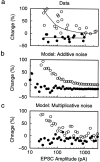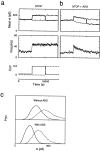Stable Hebbian learning from spike timing-dependent plasticity
- PMID: 11102489
- PMCID: PMC6773092
- DOI: 10.1523/JNEUROSCI.20-23-08812.2000
Stable Hebbian learning from spike timing-dependent plasticity
Abstract
We explore a synaptic plasticity model that incorporates recent findings that potentiation and depression can be induced by precisely timed pairs of synaptic events and postsynaptic spikes. In addition we include the observation that strong synapses undergo relatively less potentiation than weak synapses, whereas depression is independent of synaptic strength. After random stimulation, the synaptic weights reach an equilibrium distribution which is stable, unimodal, and has positive skew. This weight distribution compares favorably to the distributions of quantal amplitudes and of receptor number observed experimentally in central neurons and contrasts to the distribution found in plasticity models without size-dependent potentiation. Also in contrast to those models, which show strong competition between the synapses, stable plasticity is achieved with little competition. Instead, competition can be introduced by including a separate mechanism that scales synaptic strengths multiplicatively as a function of postsynaptic activity. In this model, synaptic weights change in proportion to how correlated they are with other inputs onto the same postsynaptic neuron. These results indicate that stable correlation-based plasticity can be achieved without introducing competition, suggesting that plasticity and competition need not coexist in all circuits or at all developmental stages.
Figures







Similar articles
-
Competitive Hebbian learning through spike-timing-dependent synaptic plasticity.Nat Neurosci. 2000 Sep;3(9):919-26. doi: 10.1038/78829. Nat Neurosci. 2000. PMID: 10966623
-
Stability and Competition in Multi-spike Models of Spike-Timing Dependent Plasticity.PLoS Comput Biol. 2016 Mar 3;12(3):e1004750. doi: 10.1371/journal.pcbi.1004750. eCollection 2016 Mar. PLoS Comput Biol. 2016. PMID: 26939080 Free PMC article.
-
Representation of input structure in synaptic weights by spike-timing-dependent plasticity.Phys Rev E Stat Nonlin Soft Matter Phys. 2010 Aug;82(2 Pt 1):021912. doi: 10.1103/PhysRevE.82.021912. Epub 2010 Aug 13. Phys Rev E Stat Nonlin Soft Matter Phys. 2010. PMID: 20866842
-
Synaptic plasticity: taming the beast.Nat Neurosci. 2000 Nov;3 Suppl:1178-83. doi: 10.1038/81453. Nat Neurosci. 2000. PMID: 11127835 Review.
-
Natural patterns of activity and long-term synaptic plasticity.Curr Opin Neurobiol. 2000 Apr;10(2):172-9. doi: 10.1016/s0959-4388(00)00076-3. Curr Opin Neurobiol. 2000. PMID: 10753798 Free PMC article. Review.
Cited by
-
Synapses learn to utilize stochastic pre-synaptic release for the prediction of postsynaptic dynamics.PLoS Comput Biol. 2024 Nov 4;20(11):e1012531. doi: 10.1371/journal.pcbi.1012531. eCollection 2024 Nov. PLoS Comput Biol. 2024. PMID: 39495714 Free PMC article.
-
Voltage-dependent synaptic plasticity: Unsupervised probabilistic Hebbian plasticity rule based on neurons membrane potential.Front Neurosci. 2022 Oct 21;16:983950. doi: 10.3389/fnins.2022.983950. eCollection 2022. Front Neurosci. 2022. PMID: 36340782 Free PMC article.
-
Systemic pharmacological suppression of neural activity reverses learning impairment in a mouse model of Fragile X syndrome.Elife. 2024 Jul 2;12:RP92543. doi: 10.7554/eLife.92543. Elife. 2024. PMID: 38953282 Free PMC article.
-
Self-organized criticality in a mesoscopic model of excitatory-inhibitory neuronal populations by short-term and long-term synaptic plasticity.Front Comput Neurosci. 2022 Oct 10;16:910735. doi: 10.3389/fncom.2022.910735. eCollection 2022. Front Comput Neurosci. 2022. PMID: 36299476 Free PMC article.
-
Homeostatic Plasticity Achieved by Incorporation of Random Fluctuations and Soft-Bounded Hebbian Plasticity in Excitatory Synapses.Front Neural Circuits. 2016 Jun 1;10:42. doi: 10.3389/fncir.2016.00042. eCollection 2016. Front Neural Circuits. 2016. PMID: 27313513 Free PMC article.
References
-
- Amarasingham A, Levy WM. Predicting the distribution of synaptic strengths and cell firing correlations in a self-organizing, sequence prediction model. Neural Comput. 1998;10:25–57. - PubMed
-
- Bell CC, Han VZ, Sugawara Y, Grant K. Synaptic plasticity in cerebellum-like structure depends on temporal order. Nature. 1997;387:278–281. - PubMed
MeSH terms
Grants and funding
LinkOut - more resources
Full Text Sources
Other Literature Sources
